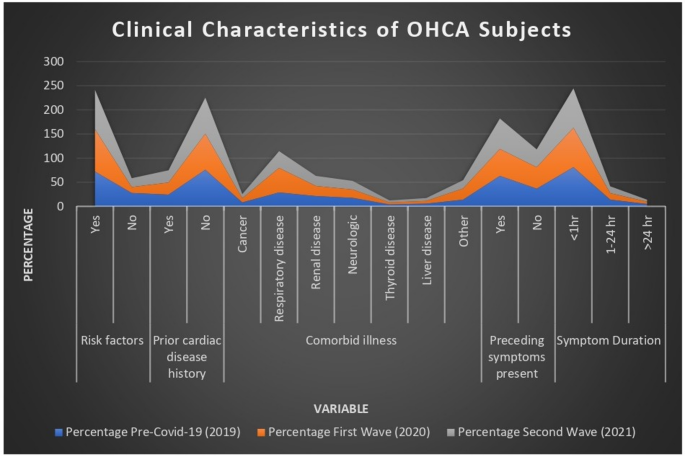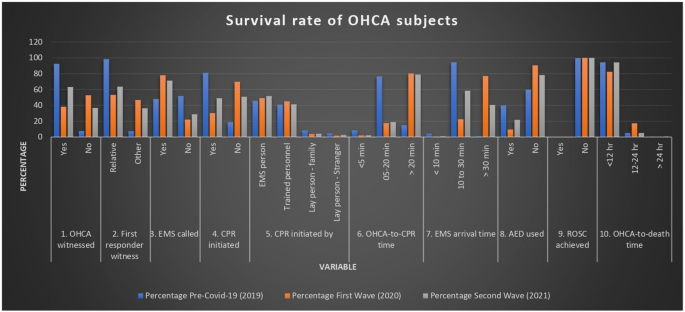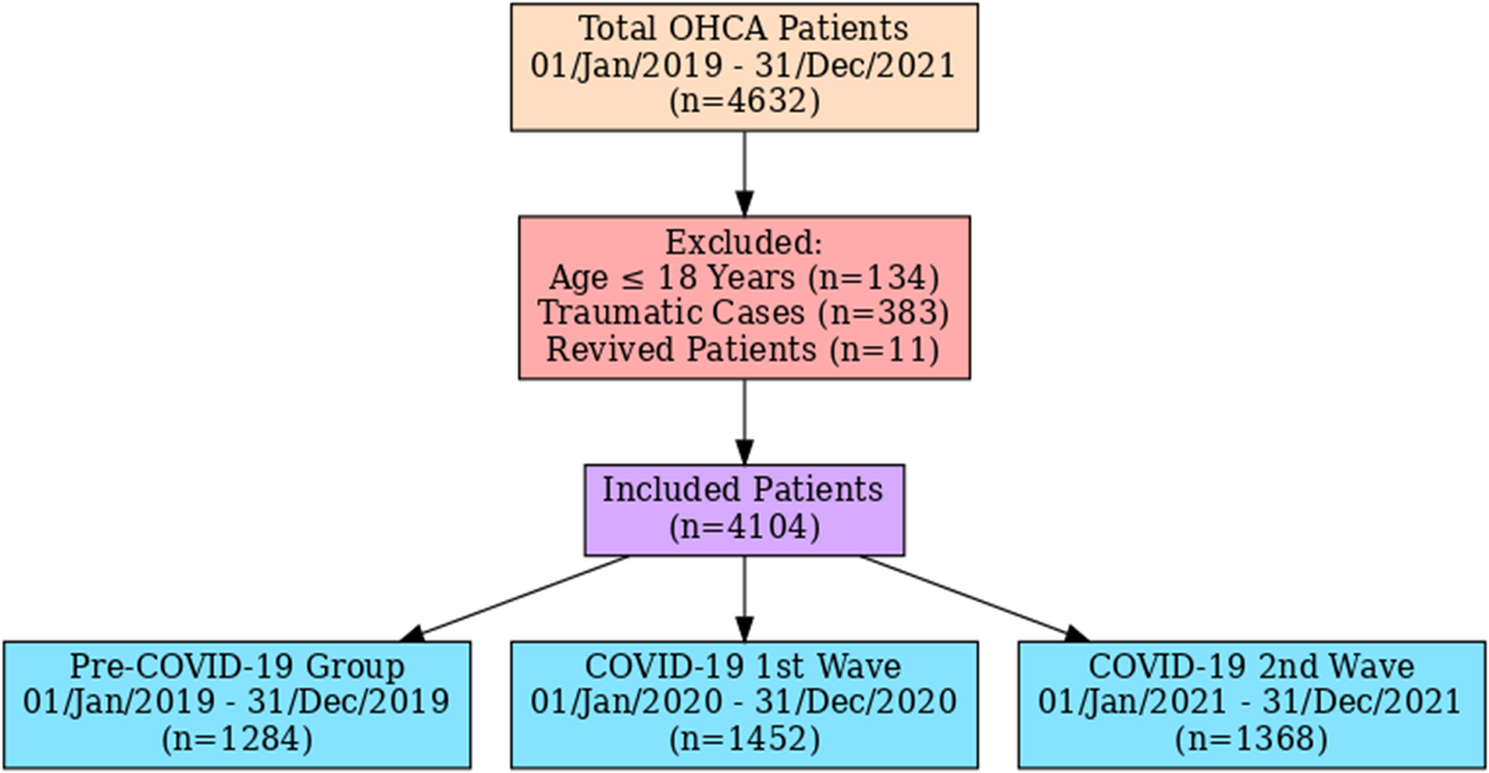During the study period, 4632 total cases of OHCA were documented. Out of which 4104 cases (1284 in 2019, 1452 in 2020, and 1368 in 2021) were eligible for inclusion in the analysis after the exclusion of the following cases: Age: ≤ 18 years (N = 134), traumatic cardiac arrest (N = 383), and revived patients (N = 11), illustrated in Fig. 1. The incidence of OHCA increased during the pandemic. During the first wave, 1452 cases were recorded, accounting for 31.34% of the total cases, while the second wave reported 1368 cases (29.53%). In comparison, the pre-pandemic period recorded 1,284 cases (27.72%). This increase during the pandemic reflects the heightened strain on healthcare systems and the potential indirect effects of COVID-19 on cardiac health.
The findings demonstrate the pandemic’s impact on OHCA incidence trends and demographic features of OHCA cases over three time periods: pre-COVID-19 (2019), the first wave (2020), and the second wave (2021). 1.
Sex distribution
Table 1; Fig. 2 illustrated that males accounted for the majority of OHCA cases in 2019, 2020, and 2021 (68.45%, 69.90%, and 68.93%, respectively). Female cases demonstrated comparable stability, ranging from 30.09 to 31.54%. The lack of significant variations suggests that the pandemic had minimal impact on OHCA incidence based on sex.
Age distribution
Individuals aged 45–60 reported approximately 60% of OHCAs across all time periods. This trend continued consistently, with percentages of 60.28% in 2019, 61.43% in 2020, and 61.18% in 2021, as shown in Table 1; Fig. 2. Approximately 25% of instances were reported by people aged > 60, with those between ages 18 and 45 accounting for only about 13%. The steady age distribution shows that the pandemic had no significant impact on the demographic profile of OHCA patients; however, it emphasises a middle-aged or older group that is disproportionately impacted by cardiac arrests.
Location of OHCA
Table 1; Fig. 2 depict that during the pandemic, the proportion of OHCAs occurring at home grew from 84.73% in 2019 to 94.14% in 2020, then marginally decreased to 88.66% in 2021. During the epidemic, there was a significant increase (p < 0.001), which could be attributed to lockdowns, limited movement, and delayed medical care. Cases in public areas decreased to 3.85% during the First Wave from 12.30% in 2019 and somewhat rebounded to 9.21% in 2021. This tendency is consistent with lower outside activity and social constraints during the pandemic. OHCA cases in healthcare settings decreased slightly throughout the pandemic, from 2.49% in 2019 to 1.65% in 2020. This decrease could be attributed to fewer in-hospital care visits for non-COVID illnesses.
Time of OHCA
Morning hours continuously accounted for the biggest share of OHCAs throughout all periods, slightly rising during the Second Wave (46.71% in 2021 vs. 44.15% in 2019), as shown in Fig. 2. Afternoon Hours: Afternoon OHCAs were consistent across all years, with roughly 28% of instances. Evening and late-night OHCAs gradually decreased from 27.49% (2019) to 25.21% (2021), as illustrated in Table 1; Fig. 2. The contemporary distribution of OHCAs indicates that pandemic-related pressure, changes in normal routines, and healthcare interruptions had no impact on cardiac arrest timing.
Baseline data for OHCA subjects during pre-COVID-19 and COVID-19 (1st and 2nd wave) outbreak groups
Risk factors
During the pandemic, there was a considerable increase in OHCA cases with identified risk factors. The statistically substantial increase (p < 0.001) can be attributed to the worsening of pre-existing conditions during the pandemic due to limited access to healthcare and delayed normal medical care. The data presented in Table 2; Fig. 3 show that the percentage of cases with no risk factors declined from 27.73% in 2019 to 12.25% in 2020, followed by a slight increase to 18.48% in 2021. The pandemic most likely resulted in underdiagnosis of asymptomatic or low-risk patients.
Prior cardiac disease history
Cases with a prior heart illness remained stable across three periods (Table 2). Prior cardiac disease continued to contribute to OHCA despite the pandemic’s impact.
Comorbid illness
Respiratory disease
During the pandemic, the prevalence of respiratory diseases ascended from 28.75% in 2019 to 50.97% in 2020, then decreased to 34.63% in 2021, as shown in Fig. 3. COVID-19 may have exacerbated respiratory problems, leading to this rise. Significant value was illustrated in Table 2. (p < 0.001).
Other comorbidities
Other comorbidities, such as renal illness, neurologic problems, thyroid disorders, and liver problems, had little variation over three periods. As reflected in Fig. 3, the percentage of “other” comorbidities increased from 14.06% in 2019 to 22.99% in 2020, indicating the impact of COVID-19 on overall health issues (p < 0.001), included in Table 2.
Preceding symptoms
According to Fig. 3, the percentage of patients who presented with prior symptoms decreased during the First Wave (55.65%) compared to 2019 (63.26%), and then returned to pre-pandemic levels in 2021 (63.09%) (p < 0.001); significant value was illustrated in Table 2. Delays in seeking medical help, either out of fear of catching COVID-19 or due to barriers to healthcare access, may be the cause of this decline in symptomatic presentation in 2020.
Symptom duration
Across all time periods, the majority of OHCA cases had symptoms for less than an hour (81.09%, 81.96%, and 81.42% in 2019, 2020, and 2021, respectively, as shown in Table 2; Fig. 3). There were few differences in cases with extended symptom durations (1–24 h or > 24 h), suggesting that the most frequent presentation of cardiac arrest was still acute symptom onset.

Clinical features of OHCA subjects during pre-COVID-19 and COVID-19 (1st and 2nd wave) outbreak groups
OHCA witnessed
Table 3; Fig. 4 show a significant decrease in the number of OHCAs witnessed (38.3%) due to the pandemic. This decrease, particularly during the First Wave, is likely due to pandemic-related variables such as increased social isolation and delayed emergency care.
The first responder witnessed
During the pandemic, there was a large decrease in relatives functioning as first responders (53.26%). However, the share of “other” first responders grew from 7.29% in 2019 to 46.74% in 2020 (Table 3; Fig. 4), which could be due to decreased family interactions and increased reliance on external support.
EMS calls and responses
Table 3 reflects that during the pandemic, the proportion of OHCAs when EMS was called in increased. EMS response times, however, substantially deteriorated. Responses under 10 min decreased from 4.36% in 2019 to barely 0.49% in 2020 and 0.93% in 2021. Responses lasting more than 30 min increased significantly, rising from 1.14% in 2019 to 77.04% in 2020 and 40.58% in 2021 (Fig. 4). This study demonstrates that the COVID-19 pandemic significantly influenced critical OHCA-related factors. During the pandemic waves, EMS response times increased substantially, with a greater proportion of cases experiencing delayed arrivals (> 30 min). This delay may have reduced the likelihood of successful resuscitation.
CPR initiation
During the epidemic, CPR initiation fell abruptly: 81.2% in 2019, 30.19% in 2020, and 49.02% in 2021. There was a greater need for EMS workers to perform CPR. 45.79% in 2019, 49.09% in 2020, and 51.81% in 2021 (Table 3; Fig. 4). Layperson participation, especially among family members, declined dramatically, most likely as a result of insufficient training, anxiety about coming into contact with COVID-19, or unwillingness to administer CPR in a high-risk setting.
Time interval between OHCA and CPR initiation
The data reflects there was a significant decrease in rapid CPR initiation (< 5 min): 8.42% in 2019, 2.12% in 2020, and 2.21% in 2021. There was a significant increase in delays (> 20 min) in starting CPR: 15% in 2019, 80.3% in 2020, and 78.92% in 2021 (Table 3). This highlights the significant lags in emergency response throughout the epidemic, which probably led to worse results (Fig. 4).
AED/Defibrillator use
Table 3 shows that during the epidemic, AED use dramatically declined: 9.46% in 2020, 21.71% in 2021, and 40.08% in 2019. A lack of availability or a decline in community-level readiness may be the cause of the decrease in access.
ROSC (Return of spontaneous Circulation)
ROSC remained exceedingly low throughout all time periods, with no survivors reported during the pandemic years (2020–2021) and only two reported prior to the pandemic (Table 3; Fig. 4). These findings indicate the consistently poor outcomes linked with OHCA, highlighting difficulties in emergency response and availability of advanced care both before and during the pandemic.
Time interval between OHCA and death
Most fatalities happened within 12 h: 94.39% in 2019, 82.44% in 2020, and 94.3% in 2021, as reflected in Table 3. In 2020, Fig. 4shows a minimal increase in the 12- to 24-hour survival rate (17.36%), potentially due to postponed medical interventions.
The pandemic’s considerable influence on OHCA outcomes and reactions is highlighted by the significant P-values (p < 0.001) for all of the aforementioned aspects. Survival odds were significantly impacted by decreased bystander involvement, EMS response delays, and decreased use of AEDs and CPR. These results highlight the necessity of public health programs to bridge gaps in the emergency response system and enhance bystander readiness and willingness in times of crisis. All significant values are illustrated in Tables 1 and 2, and 3.

Survival rate of OHCA subjects after resuscitation attempt during pre-COVID-19 and COVID-19 (1st and 2nd wave) outbreak groups
